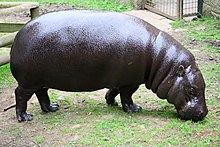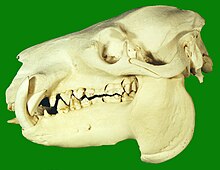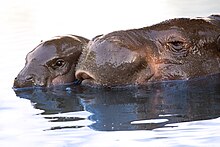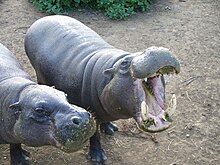Pygmy hippopotamus
| Pygmy hippopotamus | |
|---|---|

| |
| A pygmy hippopotamus at Edinburgh Zoo | |
| Scientific classification | |
| Domain: | Eukaryota |
| Kingdom: | Animalia |
| Phylum: | Chordata |
| Class: | Mammalia |
| Order: | Artiodactyla |
| Family: | Hippopotamidae |
| Subfamily: | Hippopotaminae
|
| Genus: | Choeropsis Leidy, 1853 |
| Species: | C. liberiensis
|
| Binomial name | |
| Choeropsis liberiensis | |
| Subspecies | |
| |

| |
| Range map[1] | |
| Synonyms[1] | |
| |

The pygmy hippopotamus or pygmy hippo (Choeropsis liberiensis) is a small
The pygmy hippo is reclusive and
A rare
Pygmy hippos are primarily threatened by
Taxonomy and origins
Nomenclature of the pygmy hippopotamus reflects that of the hippopotamus; the plural form is pygmy hippopotamuses or pygmy hippopotami.[5] A male pygmy hippopotamus is known as a bull, a female as a cow, and a baby as a calf. A group of hippopotami is known as a herd or a bloat.[6]

The pygmy hippopotamus is a member of the family
The
This assertion was widely accepted,
Nigerian subspecies
A distinct subspecies of pygmy hippopotamus existed in Nigeria until at least the 20th century, though the validity of this has been questioned.
The Nigerian pygmy hippopotamus ranged in the Niger River Delta, especially near Port Harcourt, but no reliable reports exist after the collection of the museum specimens secured by Ian Heslop, a British colonial officer, in the early 1940s. It is probably extinct.[1] The subspecies is separated by over 1,800 km (1,100 mi) and the Dahomey Gap, a region of savanna that divides the forest regions of West Africa. The subspecies is named after Heslop, who shot three members of it in 1935 and 1943.[14] He estimated that perhaps no more than 30 pygmy hippos remained in the region.[15]
Heslop sent four pygmy hippopotamus skulls he collected to the British Museum of Natural History in London. These specimens were not subjected to taxonomic evaluation, however, until 1969 when Gordon Barclay Corbet classified the skulls as belonging to a separate subspecies based on consistent variations in the proportions of the skulls.[16] The Nigerian pygmy hippos were seen or shot in Rivers State, Imo State and Bayelsa State, Nigeria. While some local populations are aware that the species once existed, its history in the region is poorly documented.[8]
Evolution
The evolution of the pygmy hippopotamus is most often studied in the context of its larger cousin. Both species were long believed to be most closely related to the family
This hypothesized ancestor likely split into two branches about six million years later.[19] One branch would evolve into cetaceans, the other branch became the anthracotheres, a large family of four-legged beasts, whose earliest member, from the Late Eocene, would have resembled narrow hippopotami with comparatively small and thin heads.[11]
Hippopotamids are deeply nested within the family Anthracotheriidae. The oldest known hippopotamid is the genus Kenyapotamus, which lived in Africa from 16 to 8 mya. Kenyapotamus is known only through fragmentary fossils, but was similar in size to C. liberiensis.[12] The Hippopotamidae are believed to have evolved in Africa, and while at one point the species spread across Asia and Europe, no hippopotami have ever been discovered in the Americas. Starting 7.5 to 1.8 mya the Archaeopotamus, likely ancestors to the genus Hippopotamus and Hexaprotodon, lived in Africa and the Middle East.[7]
While the fossil record of hippos is still poorly understood, the lineages of the two modern genera, Hippopotamus and Choeropsis, may have diverged as far back as 8 mya. The ancestral form of the pygmy hippopotamus may be the genus Saotherium. Saotherium and Choeropsis are significantly more basal than Hippopotamus and Hexaprotodon, and thus more closely resemble the ancestral species of hippos.[7][12]
Extinct pygmy and dwarf hippos
Several species of small hippopotamids have also become extinct in the Mediterranean in the late
These species, though comparable in size to the pygmy hippopotamus, are considered dwarf hippopotamuses, rather than pygmies. They are likely descended from a full-sized species of
Description

Pygmy hippos share the same general form as a hippopotamus. They have a graviportal skeleton, with four stubby legs and four toes on each foot, supporting a portly frame. Yet, the pygmy is only half as tall as the hippopotamus and weighs less than 1/4 as much as its larger cousin. Adult pygmy hippos stand about 75–100 cm (2.46–3.28 ft) high at the shoulder, are 150–175 cm (4.92–5.74 ft) in length and weigh 180–275 kg (397–606 lb).[21] Their lifespan in captivity ranges from 30 to 55 years, though it is unlikely that they live this long in the wild.[8][22]
The skin is greenish-black or brown, shading to a creamy gray on the lower body. Their skin is very similar to the common hippo's, with a thin
The skeleton of C. liberiensis is more gracile than that of the common hippopotamus, meaning their bones are proportionally thinner. The common hippo's spine is parallel with the ground; the pygmy hippo's back slopes forward, a likely adaptation to pass more easily through dense forest vegetation. Proportionally, the pygmy hippo's legs and neck are longer and its head smaller.[22]

The orbits and nostrils of a pygmy hippo are much less pronounced, an adaptation from spending less time in deep water (where pronounced orbits and nostrils help the common hippo breathe and see). The feet of pygmy hippos are narrower, but the toes are more spread out and have less webbing, to assist in walking on the forest floor.[22]
Despite adaptations to a more terrestrial life than the common hippopotamus, pygmy hippos are still more aquatic than all other
Behavior

The behavior of the pygmy hippo differs from the common hippo in many ways. Much of its behavior is more similar to that of a tapir, though this is an effect of convergent evolution.[9] While the common hippopotamus is gregarious, pygmy hippos live either alone or in small groups, typically a mated pair or a mother and calf. Pygmy hippos tend to ignore each other rather than fight when they meet. Field studies have estimated that male pygmy hippos range over 1.85 km2 (460 acres), while the range of a female is 0.4 to 0.6 km2 (100–150 acres).[8]
Pygmy hippos spend most of the day hidden in rivers. They will rest in the same spot for several days in a row, before moving to a new spot. At least some pygmy hippos make use of dens or
Diet
Like the common hippopotamus, the pygmy hippo emerges from the water at dusk to feed. It relies on game trails to travel through dense forest vegetation. It marks trails by vigorously waving its tail while defecating to further spread its feces. The pygmy hippo spends about six hours a day foraging for food.[8]

Pygmy hippos are
Reproduction


A study of breeding behavior in the wild has never been conducted; the artificial conditions of captivity may cause the observed behavior of pygmy hippos in zoos to differ from natural conditions. Sexual maturity for the pygmy hippopotamus occurs between three and five years of age.
Pygmy hippos consort for mating, but the duration of the relationship is unknown. In zoos they breed as monogamous pairs. Copulation can take place on land or in the water, and a pair will mate one to four times during an oestrus period. In captivity, pygmy hippos have been conceived and born in all months of the year.[9] The gestation period ranges from 190 to 210 days, and usually a single young is born, though twins are known to occur.[8]
The common hippopotamus gives birth and mates only in the water, but pygmy hippos mate and give birth on both land and water. Young pygmy hippos can swim almost immediately. At birth, pygmy hippos weigh 4.5–6.2 kg (9.9–13.7 lb) with males weighing about 0.25 kg (0.55 lb) more than females. Pygmy hippos are fully
Temperament
Although not considered dangerous to humans and generally docile, pygmy hippos can be highly aggressive at times.[25]
Conservation

The greatest threat to the remaining pygmy hippopotamus population in the wild is loss of habitat. The forests in which pygmy hippos live have been subject to logging, settling and conversion to agriculture, with little efforts made to make logging sustainable. As forests shrink, the populations become more fragmented, leading to less genetic diversity in the potential mating pool.[1]
Pygmy hippos are among the species illegally hunted for food in Liberia.[26] Their meat is said to be of excellent quality, like that of a wild boar; unlike those of the common hippo, the pygmy hippo's teeth have no value.[9] The effects of West Africa's civil strife on the pygmy hippopotamus are unknown, but unlikely to be positive.[1] The pygmy hippopotamus can be killed by leopards, pythons and crocodiles. How often this occurs is unknown.[8]
C. liberiensis was identified as one of the top 10 "focal species" in 2007 by the
History and folklore

While the common hippopotamus was known to Europeans since classical antiquity, the pygmy hippopotamus was unknown outside its range in West Africa until the 19th century. Due to their nocturnal, forested existence, they were poorly known within their range as well. In Liberia the animal was traditionally known as a water cow.[9]
Early field reports of the animal misidentified it as a
The first pygmy hippo was brought to Europe in 1873 after being captured in Sierra Leone by a member of the British Colonial Service but died shortly after arrival. Pygmy hippos were successfully established in European zoos in 1911. They were first shipped to Germany and then to the Bronx Zoo in New York City where they also thrived.[8][9]
In 1927,
Several folktales have been collected about the pygmy hippopotamus. One tale says that pygmy hippos carry a shining diamond in their mouths to help travel through thick forests at night; by day the pygmy hippo has a secret hiding place for the diamond, but if a hunter catches a pygmy hippo at night the diamond can be taken. Villagers sometimes believed that baby pygmy hippos do not nurse but rather lick secretions off the skin of the mother.[9]
References
- ^ . Retrieved 27 August 2021.
- ^ "Appendices | CITES". cites.org. Retrieved 2022-01-14.
- ^ a b "Choeropsis liberiensis". ASM Mammal Diversity Database. 1.5. American Society of Mammalogists. Retrieved 26 August 2021.
- .
- ^ "Hippopotamus".
- ^ List of animal names
- ^ .
- ^ ISBN 978-0-85661-131-5.
- ^ a b c d e f g h i j k Robinson, Phillip T. River Horses and Water Cows Archived 2009-03-26 at the Wayback Machine. Hippo Specialist Group of the World Conservation Union Archived 2007-07-17 at the Wayback Machine. Retrieved on 2007-07-30.
- ^ a b Coryndon, Shirley C. (1977). "The taxonomy and nomenclature of the Hippopotamidae (Mammalia, Artiodactyla) and a description of two new fossil species". Proceedings of the Koninklijke Nederlandse Akademie van Wetenschappen. 80 (2): 61–88.
- ^ PMID 15677331.
- ^ S2CID 83768668.
- ^ "ITIS Standard Report Page: Hexaprotodon liberiensis". www.itis.gov. Retrieved 7 December 2020.
- ISBN 978-0-19-061185-9.
- ^ World Conservation Union status survey. Archived from the originalon 2008-01-05. Retrieved 2008-08-23.
- .
- ^ "Scientists find missing link between the dolphin, whale and its closest relative, the hippo". Science News Daily. 2005-01-25. Archived from the original on 2007-03-04. Retrieved 2008-08-23.
- PMID 9159931.
- PMID 9881471.
- ^ a b Petronio, C. (1995). "Note on the taxonomy of Pleistocene hippopotamuses" (PDF). Ibex. 3: 53–55. Archived from the original (PDF) on 2008-09-12. Retrieved 2008-08-23.
- ISBN 978-0198508236.
- ^ a b c d e "Pygmy Hippo fact sheet". National Zoological Park. Archived from the original on 2008-08-25. Retrieved 2008-08-23.
- ^ "Hexaprotodon liberiensis (Madagascan pygmy hippopotamus)". Animal Diversity Web.
- ^ .
- ^ Álvarez, Juan (2023-02-05). "Are Pygmy Hippos Aggressive? Are Dangerous as The Common?". WWWILDNATURE. Retrieved 2023-05-18.
- ^ Look, Anne (8 May 2012). "Poaching in Liberia's Forests Threatens Rare Animals". Voice of America. Archived from the original on 4 March 2016. Retrieved 5 November 2014.
- ^ "Protection for 'weirdest' species". BBC. 2007-01-16. Retrieved 2008-08-23.
- ^ Administrator. "Gola Forest Reserve". Visit Sierra Leone. Archived from the original on 2010-03-08.
- .
External links
- Videos of Pygmy Hippos at Arkive.org
- Pygmy hippo caught on camera in Liberia (video), BBC News 2011-12-19
- Rare pygmy hippos caught on film, BBC News 2008-03-10
- Camera trap results, EDGE of Existence Programme). 10 March 2008. First reports showing Pygmy Hippos in wild, surviving Liberian Civil War.
- Pygmy hippos survive two civil wars, Zoological Society of London Press Release, 10 March 2008.
- Camera trap results,
- EDGE of Existence "(Pygmy hippo)", Saving the World's most Evolutionarily Distinct and Globally Endangered (EDGE) species

